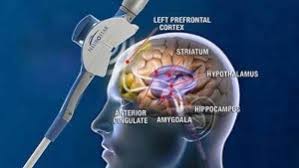The Role of rTMS in Treating Treatment-Resistant Anxiety Disorders

When worry refuses to loosen its grip despite structured therapy and regular medicines, life can start to feel paused: unanswered emails pile up, and sleep shrinks. If that sounds familiar, you are not alone. Families across India often ask for options that are safe, science-led, and practical. One option now discussed more widely is rTMS Treatment – a non-invasive method that modulates brain networks linked with attention, threat detection, and regulation. Rather than replacing therapy or medicines, it can be explored as an extra tool when standard routes have not been enough.
What is rTMS?
Repetitive transcranial magnetic stimulation uses a small coil on the scalp to deliver brief magnetic pulses to targeted circuits. Nothing is implanted, and no anaesthesia is required. In many anxiety presentations, the right prefrontal network can become over-vigilant. Stimulation plans, set by clinicians, aim to quiet this hub and support regulation. Programmes are delivered by trained teams and sit alongside psychological care and everyday routines. Guidance explains the technique, suitability, and safety rules.
How It Differs From Therapy And Medicines
| Aspect | rTMS Treatment | Talking therapies | Medicines |
| How it works | Magnetic pulses modulate network activity | Builds coping skills and new thinking patterns | Adjusts brain chemistry through prescriptions |
| Daily life | Chair-based sessions; routine often continues | Scheduled sessions with practice between | Regular dosing and reviews |
| Role in care | Option when standard routes have not been enough | Foundation across anxiety presentations | Widely used across presentations |
When People Consider It
Some individuals continue to experience restlessness, intrusive worry, muscle tension, and broken sleep even after structured therapy and adequate trials of medicines. In that setting, clinicians may discuss a carefully planned course of stimulation as part of a stepped-care approach. The decision is collaborative: what matters most in daily life – attending meetings, re-entering social spaces, or sleeping more deeply – is placed at the centre, and progress is reviewed together.
What A Course Looks Like
A typical pathway starts with mapping. The clinician identifies the scalp position linked to the chosen network and sets a safe starting intensity. During sessions, you sit in a chair and feel a tapping sensation from the coil. After the session, most people return to their usual activities. Services often combine stimulation with skills-based work, so gains generalise into home and work. Plans are adjusted if discomfort appears, and staff answer questions.
Comfort, Screening, And Safety
- Screening matters: teams ask about implants, seizures, head injuries, and current prescriptions.
- Reported effects are usually mild and short-lived, such as scalp tingling or a brief headache.
- Trained staff monitor each session and follow safety frameworks that guide parameters and emergency procedures.
- A supportive environment helps: water, snacks, and a calm waiting area make attendance easier.
What The Research Says
Peer-reviewed reviews and guidelines report encouraging results for several anxiety presentations when rTMS is compared with control conditions. The most consistent signals appear in generalised anxiety, with growing work in social anxiety and panic. Authors emphasise variability between studies and call for larger, well-controlled trials. Put simply, the direction is hopeful, and decisions should remain person-centred and cautious. Indian scholarship adds a local perspective.
| Theme | Emerging agreement | Still being studied |
| Symptom change | rTMS can reduce excessive worry, hyper-arousal, and avoidance in some individuals compared with control conditions | Optimal sites, patterns, and integration with therapy |
| Safety | When delivered under guidelines, rTMS is generally well tolerated in clinical settings | Which subgroups benefit most over time |
| Service model | Best delivered by trained teams within a stepped-care plan | How to personalise schedules and digital follow-ups |
Real-World Example
Picture Riya, a young professional who can present to a room yet feels a churn before every client call. She has learnt grounding skills and takes prescribed medicines, but the anticipatory surge still shows up. After assessment, her clinician explains how a targeted course could ease the over-vigilant loop while she keeps practising helpful skills. Her partner attends the first appointment, hears how progress will be tracked, and takes charge of calendar reminders. Small signals – joining a team huddle, finishing a call, sleeping through – are noted.
Guidance For Loved Ones
- Keep a gentle diary of small shifts.
- Ask the team how to reinforce new coping steps without pressure.
- Coordinate practical help: travel, water, snacks, or a shared playlist for the waiting area.
- Normalise zigzags. Anxiety recovery rarely moves in a straight line; steady encouragement works better than constant monitoring.
Small acts count over time.
Choosing A Service In India
Look for a mental health hospital or clinic that offers a thorough assessment, explains the chosen brain target, and shows how stimulation will sit alongside therapy and lifestyle support. Ask how the team will measure change that matters to you – sleep depth, meeting attendance, or social re-entry. In India, centres such as Sukoon Health integrate rTMS within multidisciplinary care, helping individuals and families understand the plan. Clear information and shared decisions make a difference.
Conversation Starters For Your First Visit
- Which brain circuits are you targeting for my presentation, and why?
- How will we know whether this is helping in everyday life?
- Can we combine sessions with the skills I already use?
- What will we do if sleep or appetite shifts during the course?
- How can my family support the plan without adding pressure?
Key Takeaways
- rTMS Treatment is a clinic-based, non-invasive option considered when anxiety persists despite standard care.
- Reviews and guidelines suggest cautious optimism, especially for generalised anxiety, and encourage continued high-quality research.
- Choosing a transparent, team-led service and involving loved ones helps keep decisions grounded, respectful, and hopeful.